The Elephant Nature Sanctuary is a leader in the field of elephant rescue and conservation. Started 10 years ago by Lek Chaillert, a Thai hill tribe woman from the Khamu indigenous tribe. She initially rescued injured and mistreated elephants in 1992, and in 2003 she was able to organize funding to create a permanent home for abused and injured elephants. Word spread and soon Lek was called in from various parts of Thailand to help deal with elephants in need, such as a baby whose mother had died and the hill tribe village did not know how to, nor have resources to take care of this orphan baby elephant. Another source of elephants in need stems from the fact that this region still holds countless unexploded ordinance from the American War (with Viet Nam) and elephants, like people, step on land mines.
In addition to the elephants, the sanctuary became one of the places able and willing to provide help at the time of the historic level of flooding in Bangkok (2012). The center rescued hundreds of cats and 400 dogs, many of whom are up for adoption.
Today, the “herd” she has been able to provide for and give care to at the Elephant Nature Park, numbers 39.
Even though Thailand’s history would be incomplete without reference to the contribution of the elephant in all phases of the country’s development — from providing a military advantage to Thai generals thousands of years ago, to providing un-equaled manpower to move enormous and valuable timber through the thick jungles of Thailand — and even though the elephant is revered in Thai Buddhism and the Hindu elephant-god Ganesh is found in many temples, the country has had a DISMAL record at protecting its majestic, gentle giants.
The population of Asian elephants in Thailand measured over 100,000 one hundred year ago, the loss of natural habitat and the unchecked killing by poachers for elephant ivory tusks have dwindled the population of wild elephants to a mere 3,000 as of last year. At this rate, within 10 years the Asian elephant will be extinct in Thailand, and perhaps in all of Indochina.
To make matters more complicated, when the government decided to make timber logging illegal some 5 years ago, a very positive decision from a forest protection point of view, the unintended consequence is that some 3,000 elephants lost their “job”, working in the logging industry. No longer able to receive income from the elephants, they were essentially abandoned by their owners. Some died due to lack of care, others resurfaced as “beggars” with their mahouts (trainers) in the streets of the city of Bangkok, having severe impact on their health. Some of this population of pre logging elephants has become “employed” in the tourist trade, providing rides for tourists in Northern Thailand.
What is at stake here is not only the 39 elephants at the Sanctuary, but a complete rethink about the way elephants are treated in this part of the world. The process to “break” an elephant, a naturally wild beast, into a tame giant that performs or gives rides to tourists, or carries timber in the forest, is a horrendously cruel one. Consider that elephants are EXTREMELY smart and know exactly what is happening to them. The violent process results in severe cuts, injuries (the trainers use nails at the end of sticks which) and occasionally death for the elephants whose spirit is being “broken”. Very heart wrenching to watch a video on this, read about it or even think about it.
The whole issue of elephant riding and tourism is a complex one. On one hand, a “purist” view toward animal rights would argue that any use of elephants for commercial purposes, which require the elephant to “perform” (whether by providing rides or doing “tricks”), further contributes to the exploitation of the species and provides motivation for further abuse through the “breaking” process. On the other hand, it seems that most of the tourist-oriented elephant activities are done with elephants who have become “unemployable”, as they were used in the now much diminished logging industry. The tourist dollar, from activities such as elephant rides, does provide income for the elephants’ food and care. So, given the lifespan of 80 years of an elephant, there will be several decades still of elephants that have been “broken” who need a source of revenue to pay for their upkeep. Hopefully, the trend and model demonstrated by the Elephant Nature Park, which is to pull in tourist dollars for an ALTERNATIVE path – one where humans have a rare opportunity to interact with elephants, but without rides or performance tricks, will become increasingly supported.
At the Elephant Nature Park, each elephant is assigned a caretaker (mahout) who is responsible for the well being of the elephant. Lek and her mahouts are pioneering a more enlightened approach to teaching young elephants by using love and positive reinforcement instead of pain. Only hands and words – (no sticks).
Starting from childhood, when she was fortunate enough to observe them wild and free in game parks in South Africa and Namibia, Peta has long had an affinity for the large mammal. So, it has been rather frustrating to be in Northern Thailand and not be able to go to this elephant conservatory, for lack of funds on our part. Finally, a 2 year process to recover payments from a CO2 Bambu customer came to resolution and we got paid the money we were owed. Going to this Elephant Nature Conservatory was our celebratory gift to ourselves and the elephants.
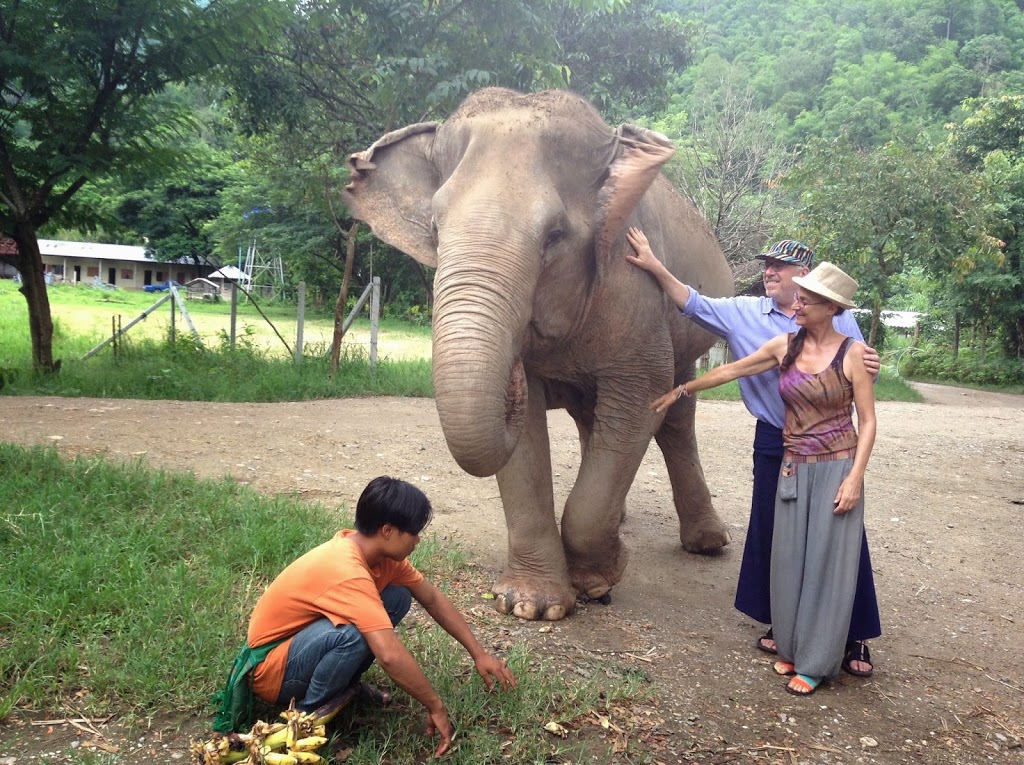 |
| Elephants roam freely in the Nature Park. Each one has a caretaker (mahout), such as the guy in the orange shirt. |
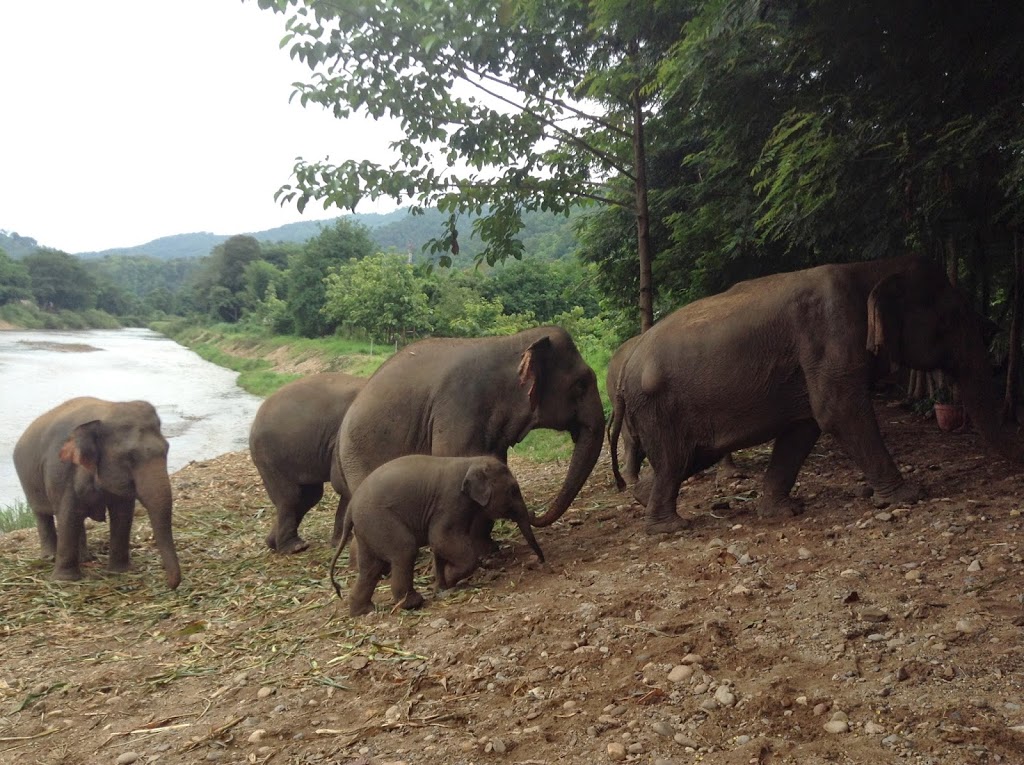 |
| While elephants come to the nature park as individuals, they soon form “family groups” of their own accord. Here a group comes up from the river, along with one of the 3 babies at the sanctuary. |
 |
| Going to the river to wash the mud off the elephants. Elephants are constantly dusting themselves with sand, in order to keep their skin cool in the hot sun. |
 |
| So amazing to be so close to this magnificent animal. A group of two adult females keep watch over the 9 month old baby elephant. |
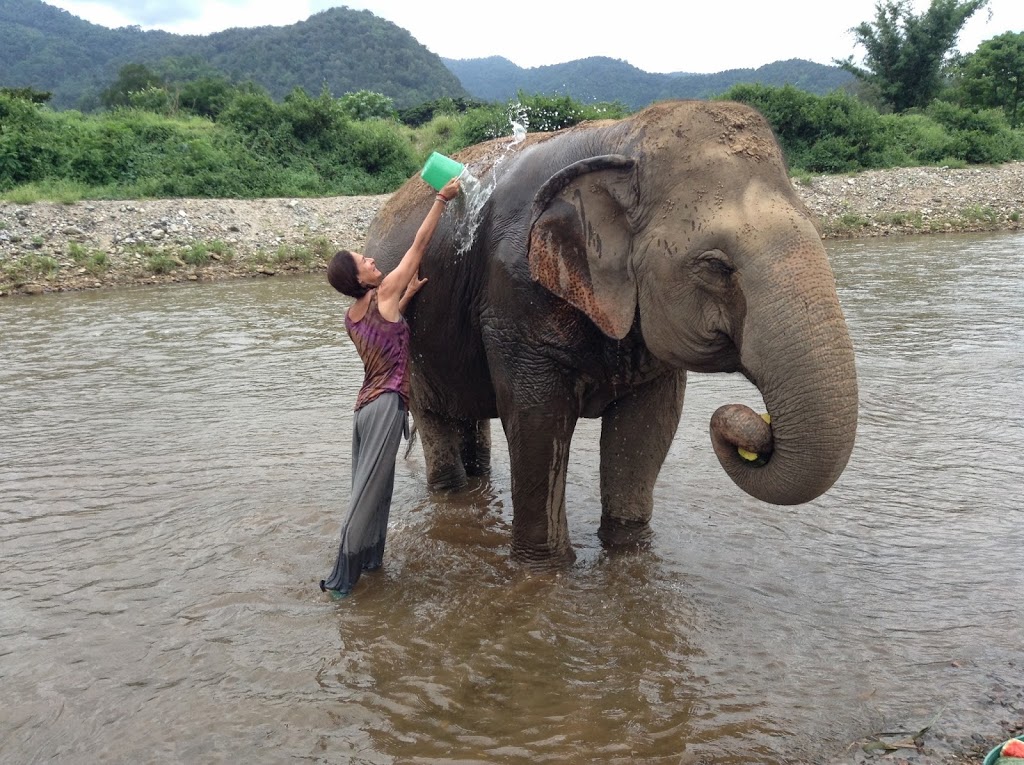 |
| This female elephant is blind in both eyes due to abuse and injury from her original owner. Now she is smiling and happy! |
 |
| One technique for having elephants interact well with humans in the context of the sanctuary, is the supply of food as positive reinforcement. |
How much food do elephants need? As the world’s largest vegetarians, elephants consume 10% of their body weight DAILY! That is a LOT of food. A one thousand pound elephant eats a 100 lbs. of food every day. It is not only expensive, but it is a logistical challenge to keep the supply of fresh fruits and vegetables coming daily to support the lives of 39 elephants. The elephants also forage for food on the land eating things like bamboo and leaves of other plants and trees.
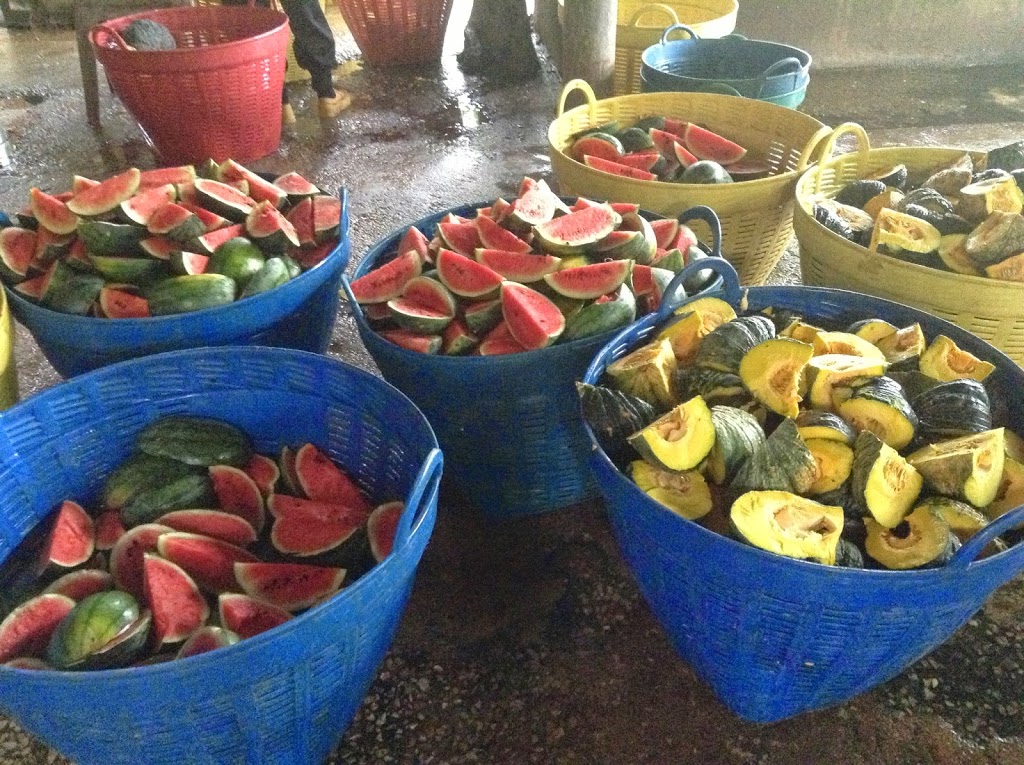 |
| This is just breakfast, for a few elephants. Each elephant consumes one of these large buckets for one meal. A mix of watermelons, squash and bananas. |
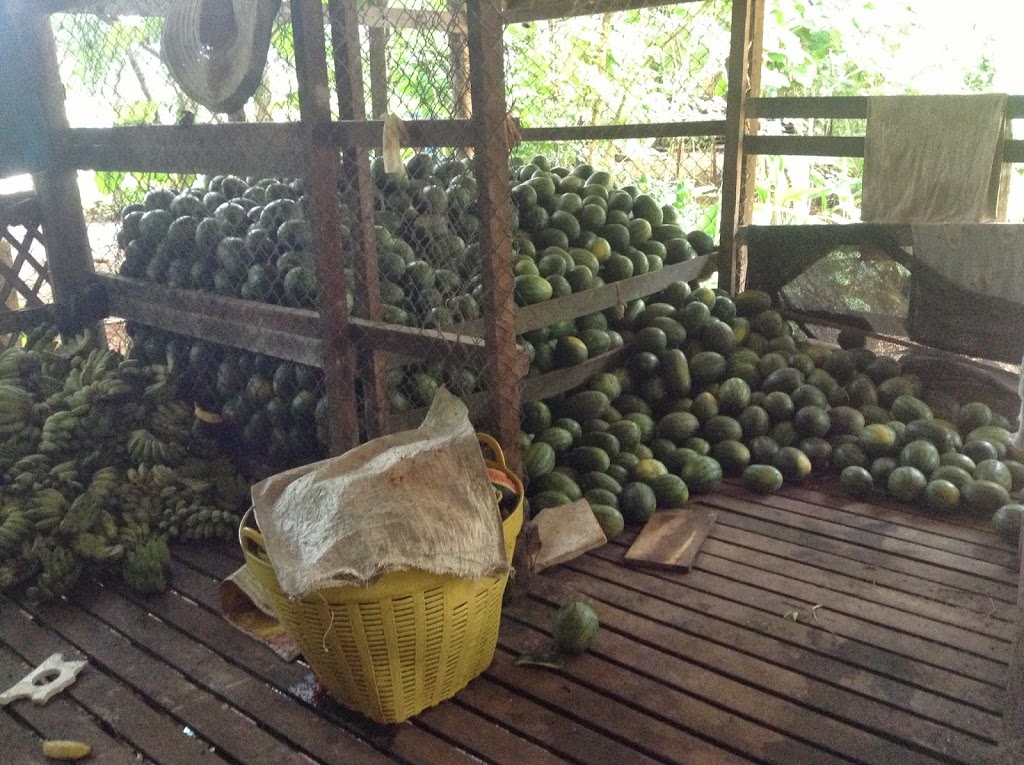 |
| Storage of piles and piles of watermelon in the elephant kitchen. |
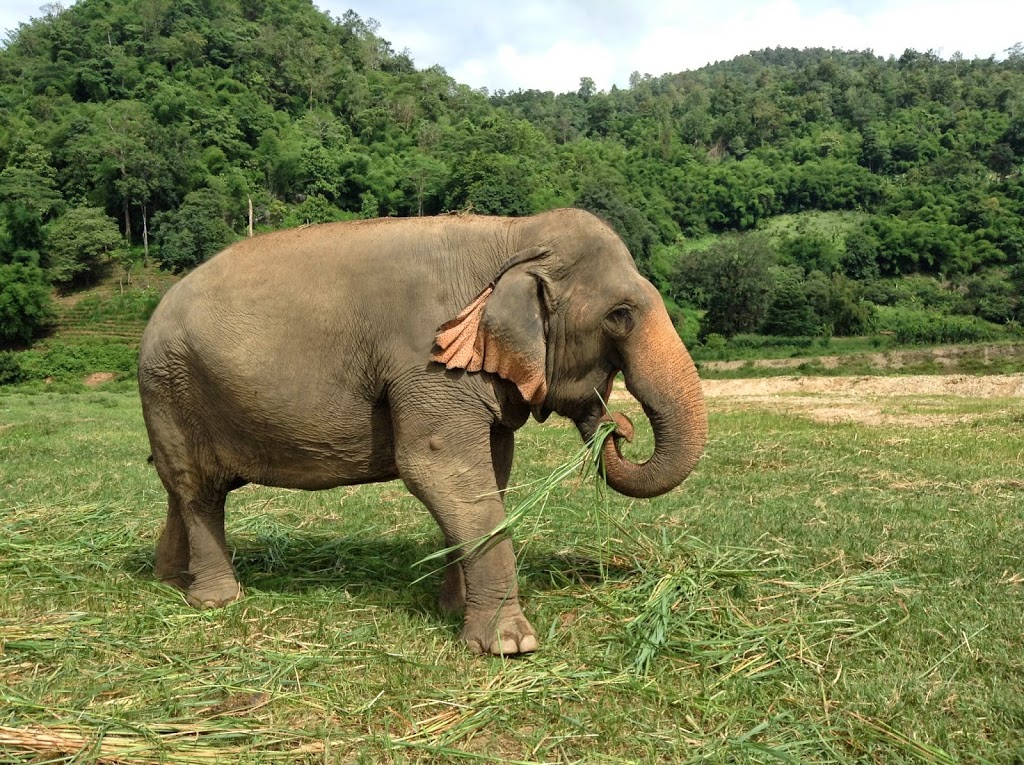 |
| Asian elephants are much smaller than African ones, and have a different coloring to their skin. The ears are also smaller and have an unusual flowery shape to them. |
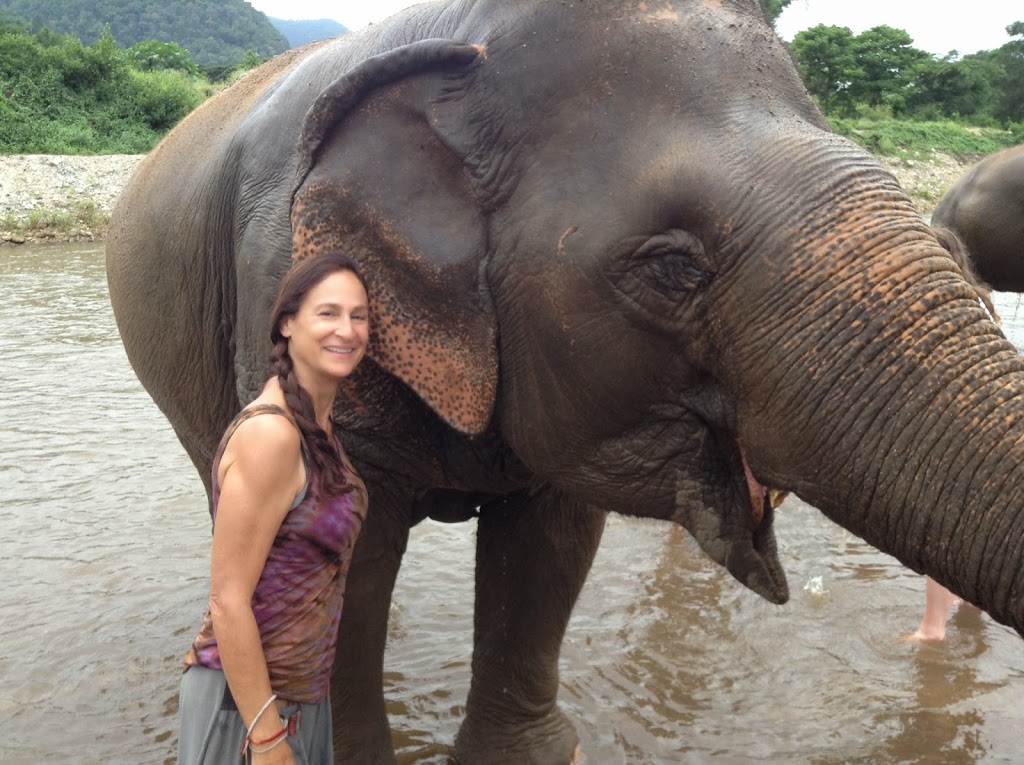 |
| What a day!! Look at those huge smiles. Mine and hers! |
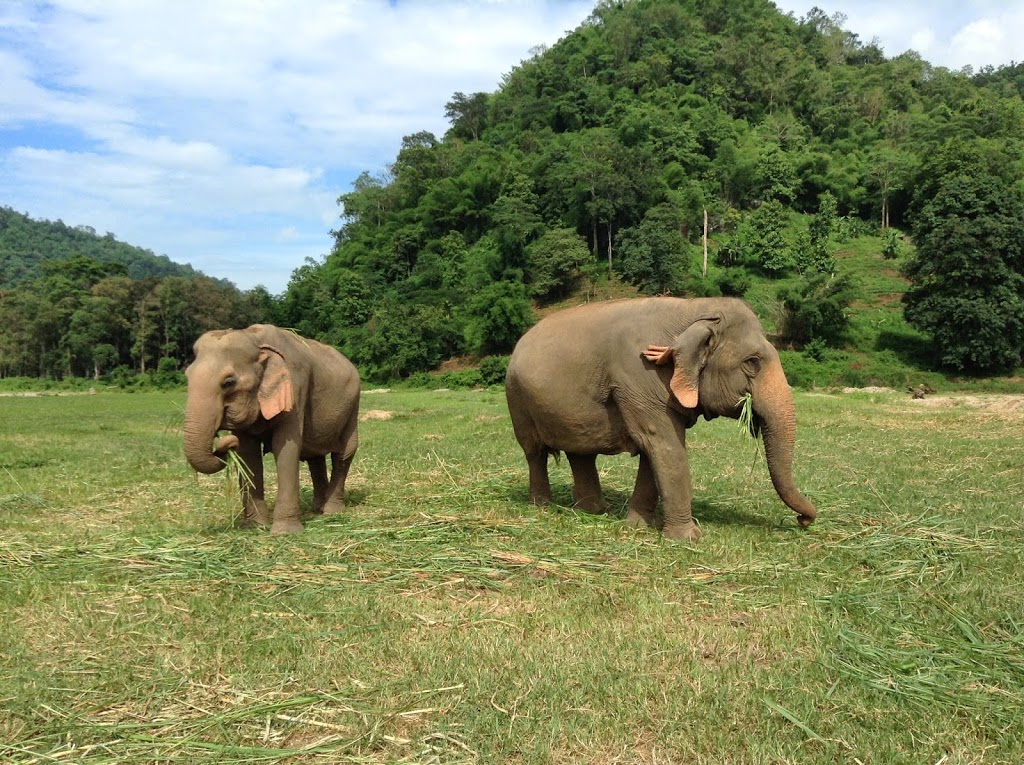 |
| Roaming freely, grazing on cut leaves and grass. The elephant on the left was severely injured when she stepped on a land mine before she was brought to the Sanctuary for treatment. |
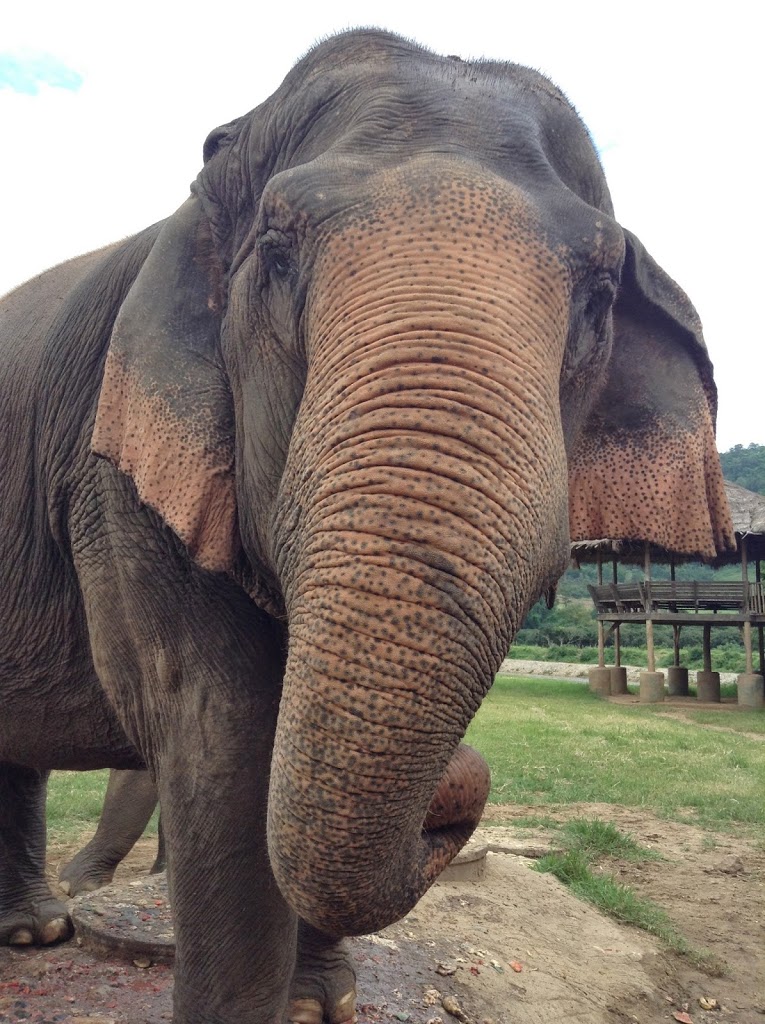 |
| Up close and personal! |
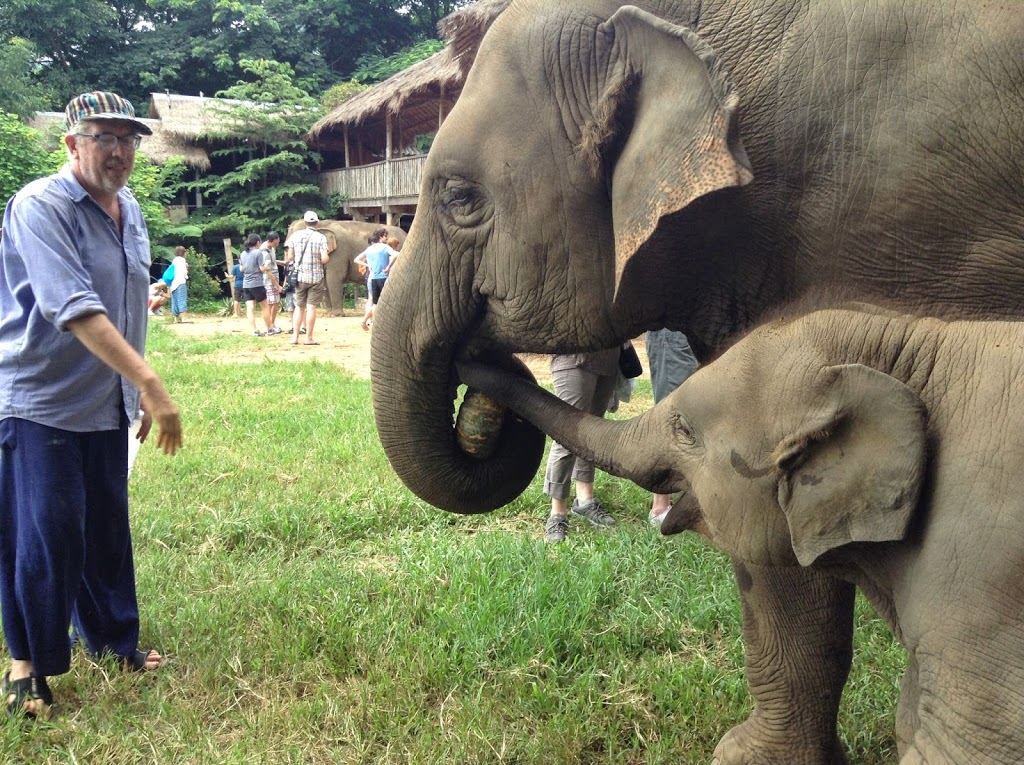 |
| Ben saying hi to the little baby. At this sanctuary, they don’t allow touching of the baby elephants to protect them from potential germs. |
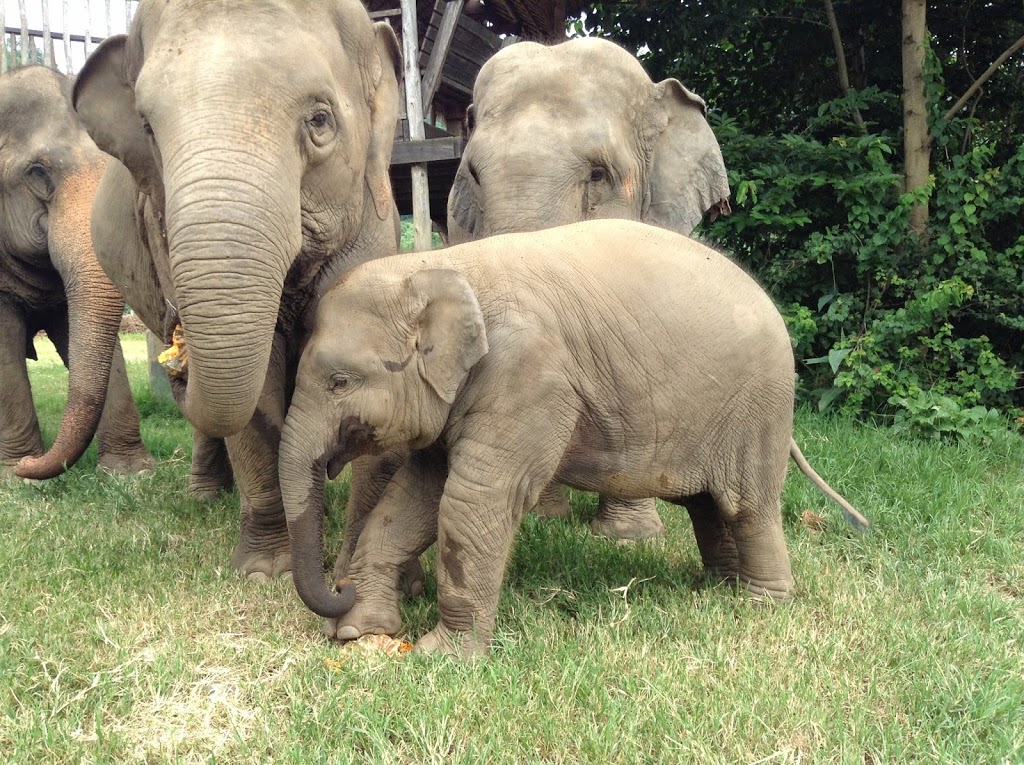 |
| The 3 babies are very playful and sometimes quite naughty. |
 |
| Schedule of daily care at the onsite elephant clinic, for the elephants with injuries. It gives a sense of how much attention they need. |
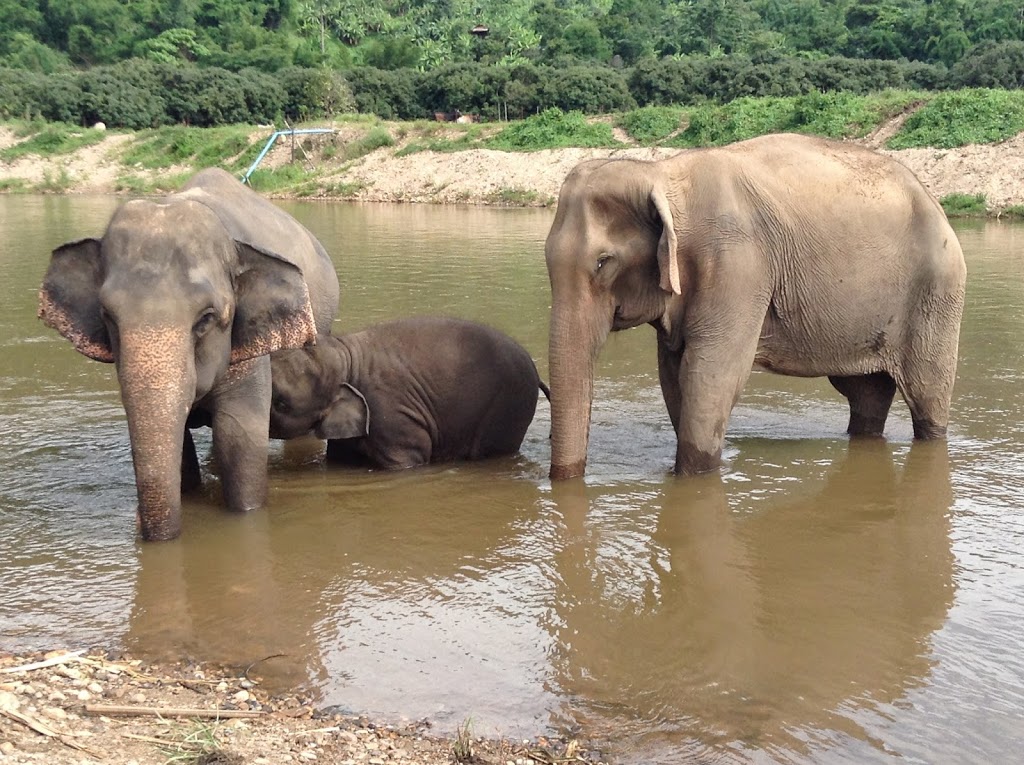 |
| This baby is having a drink from its mom, while taking a soak in the river. |
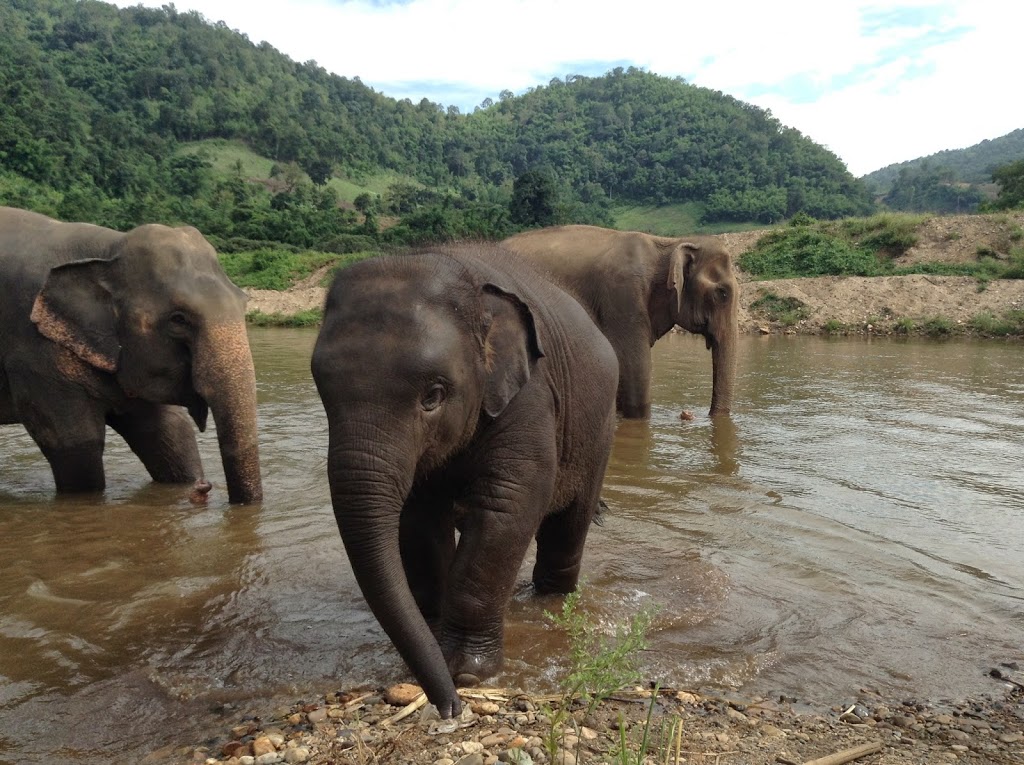 |
| Here the little baby comes out of the river. Not so little! … to get a closer look at Peta watching on the river bank. |
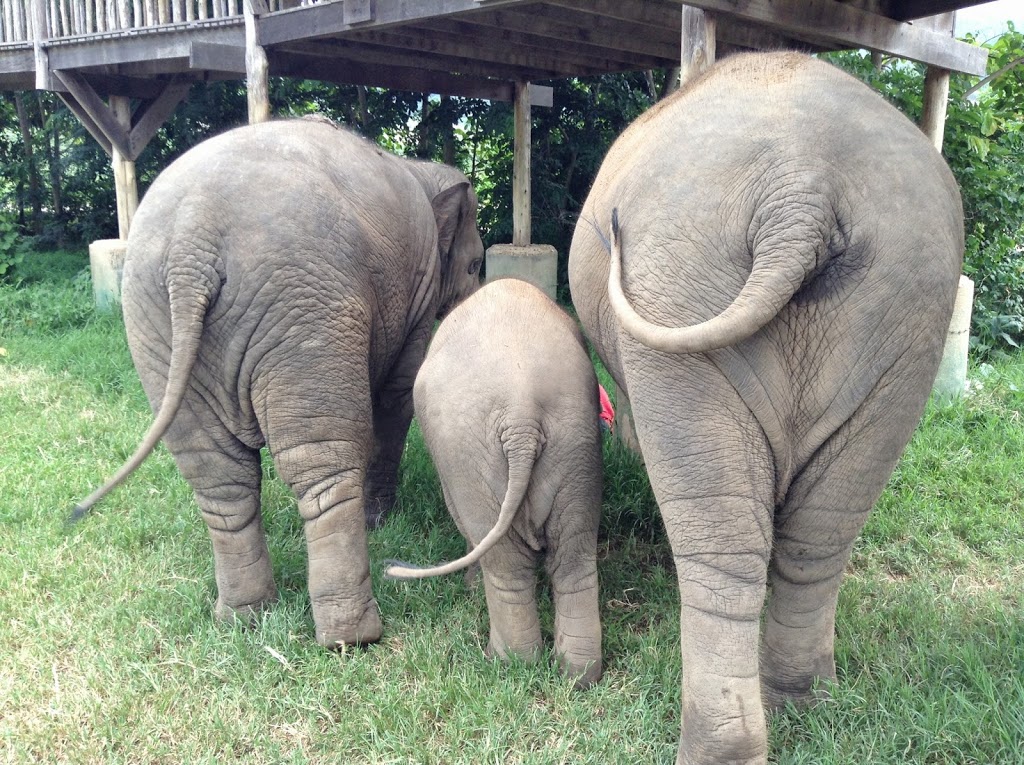 |
| Cute butts! In a pachyderm kind of way. |
 |
| Great day!!!
To make a donation to the Elephant Nature Park, to help provide food and medical treatments, please go to:
www.saveelephant.org
Your donation will be put to great use. Thanks!
You can also be a volunteer for a week at the Elephant Nature Park.
|



















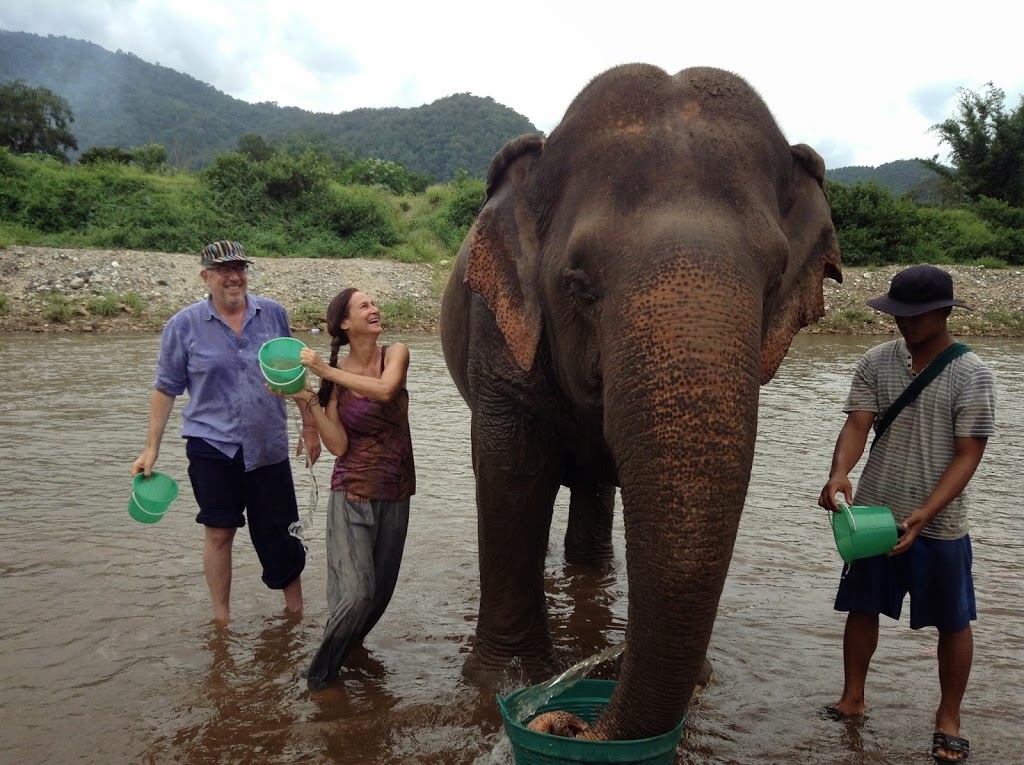

Great post. So, does the baby elephant nurse using its mouth or trunk.?
The baby elephant uses its trunk to locate the mother elephant’s teat and then uses his mouth to drink the milk.
wonderful
Fantastic! What an amazing place, and great people who work there!
Zwi, yes it really is a fantastic place… The devotion to saving abused elephants is heartwarming!
Thank you so much for raising awareness!
Thank YOU “Save the Elephant Foundation” for the amazing work and efforts!
Thanks, Lois, for your donation to the Save the Elephants Foundation! Good karma!
My sister loves elephants. I like them, too.
I’m visiting you here due to your inquiry about moving this blog. FYI, you need to enable your sharing buttons so that people (like me) can share your posts. That is one reason why you don’ t have a high readership!
And disable the Captcha!
Also, you should have pages and widgets on this site…
There are always things you can do to improve your blog!
What a fabulous read- and heartbreaking history for these beautiful and majestic creatures.
Adrienne J
Adrienne, thanks for the very positive feedback. Yes, very mixed emotions while visiting this sanctuary. Thank goodness for places like this and the unique individual, LEK CHAILLERT.